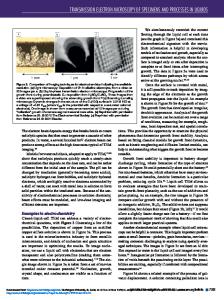In-Situ Transmission Electron Microscopy for Analysis of Ion-Beam-Growth Processes
- PDF / 3,053,382 Bytes
- 6 Pages / 414.72 x 648 pts Page_size
- 26 Downloads / 450 Views
VLADIMIR V. PANKOV, NIKOLAI E. LEVCHUK and ANATOLY P. DOSTANKO Belarusian State University of Informatics and Radioelectronics, Modern Electronics Technologies Department, Minsk 220027, Belarus ABSTRACT
Two types of systems for in situ transmission electron microscopy analysis of ion-beam etching, ion-beam sputtering and ion-beam assisted deposition are reported. Their design, operational features and some applications are presented. Radiation-stimulated diffusion in Mo-Si heterostructure, early growth of ion-beam sputtered In-Sn, In-Sn-O, ZnS:Mn films and recrystallization of In-Sn-O films during vacuum post-annealing are studied. INTRODUCTION
Energetic ion beams are employed in a number of thin film formation processes to obtain coatings properties that cannot be achieved by using thermal deposition techniques. In situ transmission electron microscopy is one of the powerful methods to study thin film growth kinetics and analyse surface reactions. This information may be used to interpret thin-film properties and to optimize the conditions of film formation. One can distinguish two general types of equipment for in situ transmission electron microscopy (TEM) analysis. The first-type of equipment implements dynamic in situ analysis and permits the studying of film formation processes in real time. But if physical or technical incompatibility of analytical and processing equipment occurs, the static in situ analysis technique may be used. The equipment of this type implies the interruption of the film formation process to carry out film analysis. There are two principal approaches to designing in situ TEM systems for analysis of ion-beam-growth processes. One is the combination of electron microscope with a processing equipment 1 6. And the other is the incorporation of the miniature processing device inside the microscope 7 - 9 . It should be noted that at the present there are no systems for in situ TEM analysis of the ion-assisted
deposition processes. In this paper the design, operational features and some applications of dynamic and static systems for in situ TEM investigation of ion-beam etching, ion-beam sputtering and ion-beam assisted deposition processes are reported. SYSTEM FOR DYNAMIC IN SITU TEM ANALYSIS OF RADIATION-STIMULATED PHASE FORMATION AND MASS TRANSPORT
A system for dynamic in situ TEM investigation has been created on the base of a commercial transmission electron microscope - X-ray microanalyser. The schematic of the system is shown in Fig. 1. The basic element of the analysing system is an ion-beam sputtering system (IBSS) built into the microscope specimen chamber. The IBSS consists of two ion sources of closed-drift type. Axial configuration of sources provides minimal distortional action on the electron beam. The system operates at the residual gas pressure of 2V10- 4 torr, operational gas pressure of 3-9y10- 4 torr and provides the generation of inert and reactive gas ion beams with the energy range of 0.5-1.5 keV and current density up to 3 mA/cm 2 . The system was used for investig
Data Loading...











